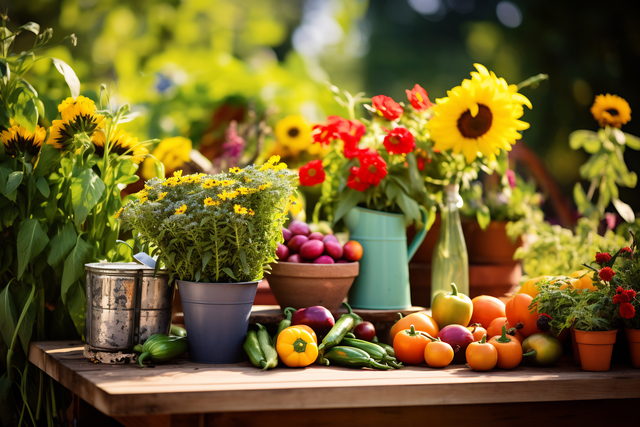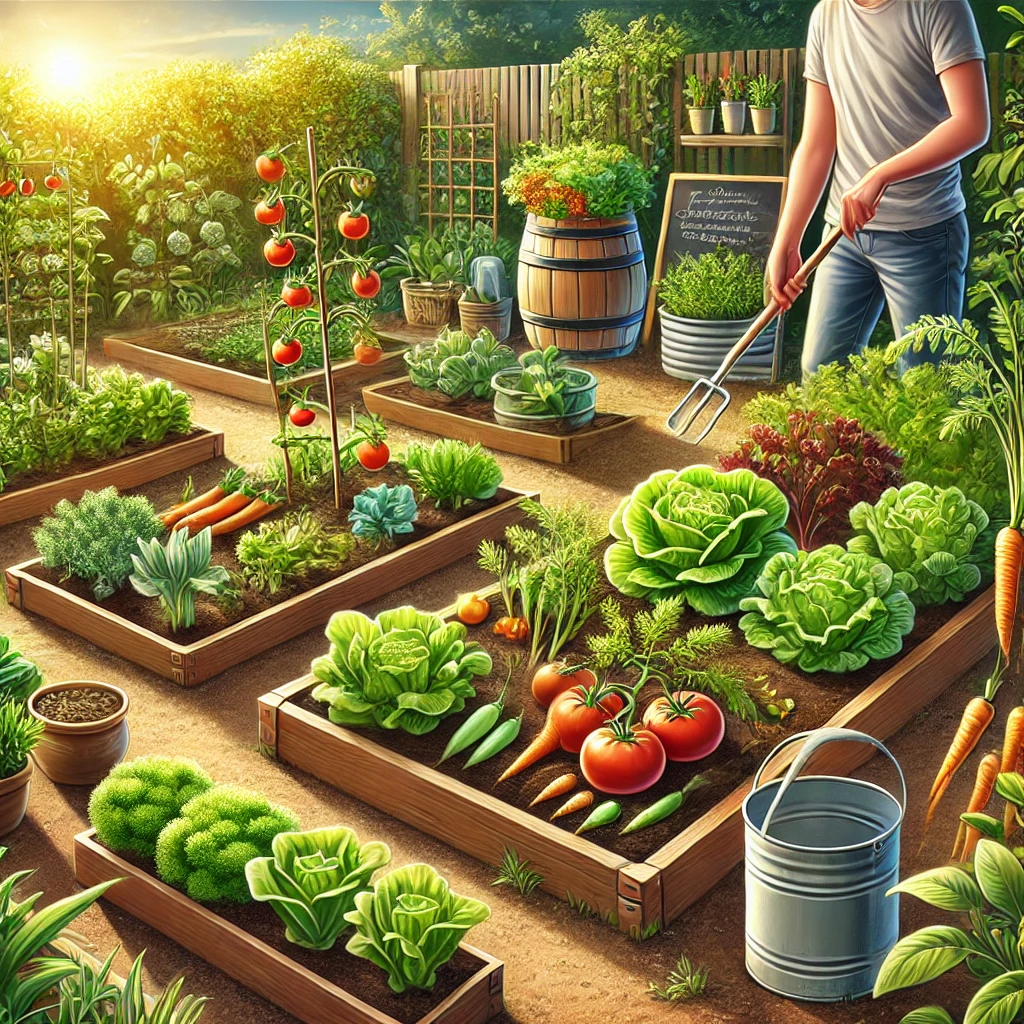Introduction
Home gardens become increasingly popular in recent years, and for good reason. Not only does it provide a fun and satisfying hobby, but it also allows individuals to grow their own fresh, healthy produce right in their backyard.
And what better way to do so than by growing organic vegetables? With the growing demand for organic produce, many people are turning to home gardening as a way to ensure they have access to high-quality, chemical-free vegetables.

In this ultimate guide, we will cover everything you need to know about growing organic vegetables at home, from choosing the right plants to harvesting your own delicious produce. Get ready to dig in and discover the joys of home gardens and the benefits of organic vegetables.
The Benefits of Growing Your Own Home Gardens
Interior Home Gardens
Gardening has become increasingly popular in recent years, and for good reason. Not only does it provide a fun and satisfying hobby, but it also allows individuals to grow their own fresh, healthy produce right in their backyard. And what better way to do so than by growing organic vegetables?
Organic gardening is not just a trendy buzzword; it offers a multitude of benefits for both you and the environment. By choosing to grow your own organic vegetables at home, you are taking control of what goes into your food and ensuring that you and your family are consuming high-quality, chemical-free produce.
Organic Home Gardens
One of the main benefits of organic gardening is the improved taste and flavor of the vegetables. Without the use of synthetic pesticides and fertilizers, organic vegetables have a natural, robust taste that cannot be replicated by store-bought produce.
Imagine biting into a ripe, juicy tomato straight from your home gardens – the burst of flavor is unparalleled.Additionally, organic gardening is environmentally friendly. It promotes biodiversity by avoiding the use of harmful chemicals that can harm beneficial insects and pollinators.
Creating a healthy ecosystem
By creating a natural, pesticide-free environment, you are supporting a healthy ecosystem and contributing to the overall health of the planet.Not only does organic gardening benefit you and the environment, but it also promotes self-sufficiency and sustainability.
By growing your own Home Gardens, you can reduce your reliance on commercially grown produce, which often has to travel long distances to reach your plate. This reduces your carbon footprint and supports local agriculture.
So, whether you have an expansive backyard or just a small interior garden, embracing organic gardening is a wonderful way to connect with nature, improve your health, and create a more sustainable future. Stay tuned as we explore the essential tips and tools for successful organic growth in our next section.
Preparing Your Garden: Essential Tips and Tools for Successful Organic

Creating a successful organic Home Gardens
Growth Creating a successful organic Home Gardens requires some essential tips and tools. Whether you have an expansive backyard or just a small interior garden, these preparations will set you up for a bountiful harvest.
First and foremost, you’ll need to choose the right location for your garden. Select an area that receives ample sunlight, as most vegetables thrive in at least 6-8 hours of direct sunlight per day.
Consider the layout of your space and make sure it’s easily accessible for maintenance and watering. If you have limited space, don’t fret! Interior home gardens has become increasingly popular, and you can easily grow vegetables indoors with the help of grow lights or by utilizing sunny windowsills.
Preparing the soil
Next, you’ll need to prepare the soil. Organic vegetables thrive in nutrient-rich soil, so start by testing your soil’s pH levels. You can purchase a simple soil testing kit at your local garden center or use an online service.
Based on the results, you may need to amend your soil with organic compost, peat moss, or other organic matter to achieve the ideal pH balance.Once your soil is ready, it’s time to start preparing your garden beds.
Consider using raised beds, which offer better drainage and weed control. If you choose to go with traditional ground-level beds, be sure to remove any grass or weeds and loosen the soil with a garden fork or tiller. This will allow your vegetables’ roots to penetrate the soil easily.
Choose the right tools
To ensure a successful organic Home Gardens, it’s crucial to choose the right tools. Invest in high-quality hand tools such as a trowel, hand rake, and pruners. These will come in handy for planting, weeding, and pruning your vegetables.
A sturdy Home Gardens hose with an adjustable spray nozzle is essential for watering, while a compost bin will allow you to recycle kitchen scraps into nutrient-rich compost for your garden.
Choosing the Right Crops: A Comprehensive List of Organic Vegetables Perfect for Home Gardening
which plants to include in your garden.
Choosing the right crops is a crucial step in growing your own organic Home Gardens. With a wide variety of options available, it can be overwhelming to decide which plants to include in your home gardens.
But fear not! We have compiled a comprehensive list of organic vegetables that are perfect for home gardening. Whether you have a large backyard or are limited to interior gardening, there is a crop for every home vegetable enthusiast.
List of organic vegetables
Let’s start with leafy greens, a staple in any organic garden. Spinach, kale, and lettuce are all excellent choices. They are easy to grow and packed with nutrients, making them a healthy addition to your meals. If you’re looking for something with a bit more flavor, consider planting herbs like basil, mint, and cilantro. Not only will they enhance the taste of your dishes, but they also add a delightful fragrance to your garden.
For those with a bigger space, tomatoes, peppers, and cucumbers are popular options. Tomatoes come in a variety of sizes and colors, allowing you to experiment with different flavors and textures. Peppers, on the other hand, range from mild and sweet to spicy and hot, catering to different taste preferences. And who can resist the crunch of freshly picked cucumbers?
limited space for interior gardening
If you have limited space for interior home gardens, consider growing microgreens. These tiny plants are packed with nutrients and can be harvested in just a few weeks. Some popular choices include broccoli, radish, and sunflower shoots. They are not only delicious but also add a vibrant touch to your meals.
Remember to choose crops that suit your region’s climate and growing season. Consider factors like temperature, sunlight, and soil conditions when making your selections. With the right crops, you’ll be on your way to a flourishing home garden and a bountiful harvest. Happy gardening!
From Seed to Harvest: A Step-by-step Guide on How to Grow Your Chosen Organic Vegetables
Now that you’ve prepared your garden and chosen the perfect home gardens for your home agriculture, it’s time to delve into the exciting process of growing your own delicious produce from seed to harvest. Whether you’re practicing interior gardening or tending to a bountiful backyard, this step-by-step guide will take you through the journey of nurturing your chosen organic vegetables.
1. Start by preparing the soil: Make sure the soil is loose and well-drained. Remove any weeds or grass from the area and mix in some organic compost or well-rotted manure to provide your plants with the necessary nutrients.
2. Planting the seeds: Follow the instructions on the seed packets for the recommended depth and spacing for each type of vegetable. Gently press the seeds into the soil and cover them with a thin layer of soil or vermiculite.
3. Watering: Keep the soil consistently moist, but not waterlogged. Avoid overwatering, as it can lead to root rot. Water your plants in the morning or evening when the temperature is cooler to prevent evaporation.
4. Providing support: Some vegetables, like tomatoes and climbing beans, may require support as they grow. Install trellises, cages, or stakes to help them grow vertically and prevent them from sprawling on the ground.
5. Nurturing the plants: Keep an eye out for pests and diseases and take necessary measures to protect your plants. This can include using organic insecticides or companion planting to deter pests. Regularly weed around your plants to prevent competition for nutrients.
Remember, home gardens is a process that requires patience and care. By following these step-by-step guidelines, you’ll be well on your way to a thriving garden full of nutritious, organic vegetables. Enjoy the satisfaction of growing your own food and reap the rewards of your hard work! Happy gardening
Overcoming Challenges: Common Problems in Organic Vegetable Gardening and Their Solutions
Gardening, especially organic Home Gardens, comes with its fair share of challenges. From pests to weather conditions, there are many obstacles that can hinder the success of your home garden.
However, with a little knowledge and some proactive measures, you can overcome these challenges and continue to enjoy the benefits of organic gardening.One common challenge faced by organic gardeners is pests.
The pesky home gardens
These pesky critters can wreak havoc on your plants, devouring leaves and causing significant damage. The key to managing pests organically is prevention. Encourage natural predators like ladybugs and birds to frequent your home gardens by planting flowers that attract them.
You can also create physical barriers such as netting or row covers to keep pests at bay. Additionally, homemade organic sprays using ingredients like neem oil or garlic can act as natural insect repellents.
weather
Another challenge in organic Home Gardens is unpredictable weather. Extreme temperatures, heavy rain, or drought can all impact the health of your plants. To mitigate the effects of these weather conditions, consider using protective covers, such as cloches or cold frames, to shield your plants. Additionally, mulching around the base of your plants can help retain moisture and regulate soil temperature.
The spread of diseases
vertical gardening techniques
Lastly, limited space can be a challenge for those practicing interior gardening. However, vertical gardening techniques, such as using trellises or hanging baskets, can maximize your available space.
Additionally, choosing compact varieties of vegetables or opting for microgreens can allow you to grow a wide range of vegetables in a small area.Overcoming the challenges of organic Home Gardensgardens requires patience, vigilance, and a bit of creativity.
By implementing preventative measures and staying proactive, you can successfully navigate the hurdles that come your way. With each challenge you conquer, you’ll become a more skilled and confident gardener, ready to enjoy the rewards of your organic vegetable garden. Happy gardening!
Post-Harvest: How to Preserve and Utilize Your Organic Produce
Preserve and utilize your fresh produce
Once you’ve harvested your bountiful organic vegetables, it’s time to explore the many ways to preserve and utilize your fresh produce. Preserving your organic vegetables not only extends their shelf life but also allows you to enjoy the fruits of your labor long after the harvest season has ended.
Plus, it’s a great way to ensure you have access to nutritious, homegrown vegetables throughout the year. So, let’s dive into some post-harvest tips and techniques for preserving and utilizing your organic produce.
Freezing your organic vegetables.
One popular preservation method is canning. This involves sealing vegetables in glass jars and heating them to kill bacteria, preventing spoilage. Canned vegetables can be stored for months and retain much of their flavor and nutritional value. Another option is freezing your organic vegetables.
Blanch them briefly in boiling water, then quickly cool them in ice water before placing them in airtight containers or freezer bags. Freezing preserves the texture and nutrients of the vegetables, making them perfect for soups, stir-fries, and other dishes.
Preserve organic vegetables by dehydrating
Dehydrating is another excellent way to preserve Home Gardens.You can use a dehydrator or even your oven set to a low temperature. Once dehydrated, vegetables can be stored in airtight containers and used in soups, stews, or as nutritious snacks. Fermentation is also gaining popularity among home gardeners.
This preservation method involves adding salt or a starter culture to vegetables and allowing them to ferment in a brine solution. Fermented vegetables, such as sauerkraut and pickles, not only last longer but also provide beneficial probiotics for a healthy gut.
The possibilities are endless
Aside from preserving, utilizing your organic produce in various recipes is a delightful way to enjoy the flavors of your home gardens year-round. Experiment with different dishes, from roasted vegetable medleys to fresh salads and homemade sauces. You can also blend your harvested vegetables into nutrient-packed smoothies or create vibrant vegetable-based soups.
By preserving and utilizing your organic produce, you can savor the flavors and nutritional benefits of your garden all year long. So, don’t let your hard work go to waste. Explore different preservation methods, get creative in the kitchen, and make the most of your homegrown vegetables. Your taste buds and your health will thank you. Happy preserving and cooking!
Continuous Harvesting: Rotating and Replanting for a Year-Round Vegetable SupplyWhen it comes to organic vegetable gardening, one of the keys to success is continuous harvesting. By rotating and replanting your crops, you can ensure a year-round supply of fresh, homegrown vegetables. This not only maximizes the productivity of your garden but also allows you to enjoy a diverse array of vegetables throughout the seasons.
Technique for continuous harvesting
One method of continuous harvesting is crop rotation. This involves planting different types of vegetables in different areas of your garden each year. By rotating crops, you can prevent the build-up of pests and diseases, as well as balance the nutrient needs of your plants. For example, if you grew tomatoes in one area this year, next year, you can plant leafy greens like spinach or kale in that same spot. This practice helps break the pest and disease cycle while replenishing the soil with nutrients.
Another technique for continuous harvesting is succession planting. This involves planting a new crop as soon as one is harvested, ensuring a continuous supply of vegetables throughout the growing season. For example, after harvesting your first batch of lettuce, you can immediately sow another round of seeds to ensure a steady stream of fresh greens.
Practice continuous harvesting
If you have limited space for Home Gardens, you can still practice continuous harvesting. Opt for compact varieties of vegetables that mature quickly, such as cherry tomatoes, dwarf peppers, or bush beans. This way, you can continuously harvest small quantities of vegetables throughout the year, even indoors.
Continuous harvesting is a wonderful way to make the most of your organic vegetable garden. By rotating and replanting your crops, you can enjoy a steady supply of fresh, Home Gardens produce all year long. Embrace this practice, and you’ll never run out of delicious vegetables for your meals. Happy harvesting
Community Involvement: Sharing the Joy and Harvest of Organic Vegetable Gardening
Community involvement is a vital aspect of organic vegetable gardening that not only enhances the experience but also brings people together. By sharing the joy and harvest of your organic Home Gardens, you can create a sense of community, inspire others to embrace sustainable practices, and even contribute to local food initiatives.
One way to involve the community is by hosting gardening workshops or classes. Share your knowledge and passion for Home Gardens with others by teaching them the basics of starting their own vegetable garden. Provide tips, demonstrations, and hands-on activities to empower individuals to grow their own organic produce. These workshops can be held in your backyard or at local community centers, schools, or libraries.
Promote sustainable practices
Another way to engage the community is by starting or participating in a community garden. These shared gardening spaces allow individuals from all backgrounds to come together, learn from each other, and cultivate their own organic vegetables. Community gardens not only promote sustainable practices but also foster a sense of camaraderie and create opportunities for social interaction.
You can also get involved with local food initiatives, such as food banks or soup kitchens. Donate excess produce from your garden to help those in need. By providing fresh, organic vegetables, you are contributing to the health and well-being of your community.
Final Thoughts: Enhancing your Lifestyle through Organic Vegetable Gardening
Organic vegetable gardening has the power to enhance your lifestyle in countless ways. Not only does it provide you with a bountiful harvest of delicious and nutritious produce, but it also allows you to connect with nature, improve your health, and create a more sustainable future. The joys of home gardens, whether you have an expansive backyard or just a small interior garden, are endless.
By embracing organic vegetable gardening, you are taking control of what goes into your food and ensuring that you and your family are consuming high-quality, chemical-free produce. There is something incredibly satisfying about watching your vegetables grow from seed to harvest and knowing that you played a role in their journey.
Creating a natural, pesticide-free environment
But the benefits of organic vegetable gardening go beyond just the personal level. By supporting local agriculture and reducing your carbon footprint, you are contributing to the overall health of the planet. By creating a natural, pesticide-free environment, you are supporting biodiversity and promoting a healthy ecosystem.
In addition, organic vegetable gardening offers opportunities for community involvement and sharing. Whether you host gardening workshops, participate in community gardens, or donate excess produce to local food initiatives, you can inspire others to embrace sustainable practices and contribute to the well-being of your community.
CONCLUSION
So, whether you are a seasoned gardener or just starting out, organic vegetable home gardens is a rewarding and fulfilling endeavor. Embrace the joys of growing your own food, enhance your lifestyle, and make a positive impact on the world. Get your hands dirty, savor the taste of homegrown vegetables, and experience the countless benefits that organic gardening has to offer. Happy gardening!







